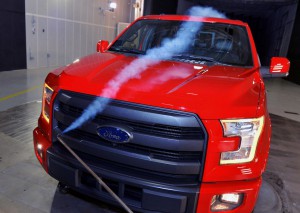
Ford plans to spend $200 million on a new vehicle testing facility that includes and advanced wind tunnel.
The Ford Motor Co. plans to spend $200 million for new wind tunnel at its principal engineering center in Dearborn, Michigan.
“This investment in new world-class test facilities underpins Ford’s ongoing commitment to advance our capabilities to continue to provide our customers with high-quality vehicles,” said Raj Nair, Ford executive vice president, global product development and chief technical officer.
The new wind tunnel complex will sit on 13 acres next to Ford’s Driveability Test Facility in Allen Park, Michigan. The complex will house new technology that delivers state-of-the-art real-world driving simulations to advance improvements in fuel economy. Construction is scheduled to begin later this year.
To accommodate large-frame vehicles, including Super Duty trucks, the new aerodynamic complex will “super-size” wind tunnel chambers, Ford officials said.
(Auto CEOs ask for CAFE break. To get the details, Click Here.)
“This new wind tunnel facility will not only allow us to test our performance and racing vehicle line-up but will also enable us to share innovations across all our global Ford products,” said Dave Pericak, Ford Performance global director.
Ford said the appetite of consumers for vehicles with greater fuel efficiency and performance led to the investment in the new complex, which will house a next-generation rolling road wind tunnel and state-of-the-art climatic chamber.
The new facility will come complete with testing advancements that better match the technological development of Ford products – both production vehicles and racing vehicles.
(To see more about Ford investing $1 billion in self-driving company, Click Here.)
Dennis Paige, lab manager for Ford’s Driveability Testing Facilities, points out that advanced features, development and innovation require that testing and verification technology keep pace with the evolution of the automobile and the industry as a whole. That’s where the new facility comes into play.
Ford’s new wind tunnel complex better positions its engineers to conduct testing that proves out advancements in vehicle design. A new five-belt conveyor system can replicate real-world drag through a rolling road aerodynamic tunnel that enables Ford to bring the road to the vehicle, rather than the vehicle to the road.
Together with the rolling road, the wind tunnel complex will produce full environmental airflow simulation, with speeds up to 200 mph. This expanded air-flow will enable engineers to validate vehicle designs at a higher quality and repeatability. This strengthens testing for aerodynamic shielding, high-speed performance and other design features.
(Ford reveals plans to dive deeper into mobility alternatives. Click Here to see what it’s working on.)
The climatic chamber can get as low as minus 40 degrees Fahrenheit, colder than the Arctic, and as high as 140 degrees Fahrenheit, hotter than the Sahara.
